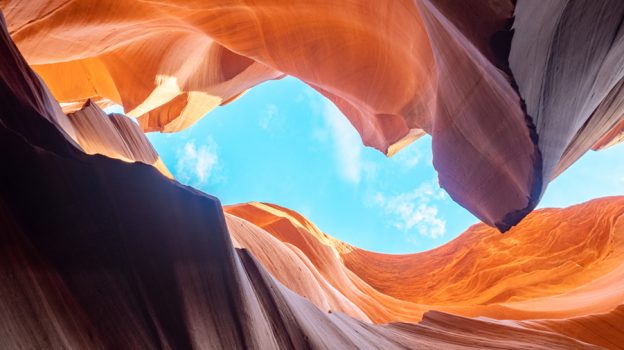
There may be nothing more beautiful in the world than the art that nature creates over time. This is especially true for a small, nondescript patch of land near Page, Arizona within the LeChee Chapter of the Navajo Nation – the home of the world famous Antelope Canyon.
Tens of thousands of years ago, this sacred land was covered in sand dunes. Slowly, over the course of millenia, those sand dunes compressed into sandstone. During rain storms and monsoons – something Arizona is known for in summer months – water would rush down the nearby mesas and carve into the sandstone, gradually creating slot canyons barely visible above ground. Over the years, the rushing water would continue to flow down to the canyon, creating whirlpools over the small openings above ground, and sending water running down into the canyon, carving unique patterns all along the walls.
Today, Antelope Canyon is one of the most popular tourist attractions on the face of the Earth – often referred to as the Eighth Wonder of the World. It is a slot canyon, approximately 7.5 miles in length, with two points of entry that you can visit – known as Upper Antelope Canyon and Lower Antelope Canyon. Slot canyons are canyons that are significantly deeper than they are wide, formed from the erosion of water flowing vertically through the sandstone with tremendous force – usually the result of flash flooding. Flash floods, like the ones that occur frequently in Arizona during monsoon season, can sweep away cars, destroy buildings and carry more force than a Category 5 hurricane. As such, certain points in Antelope Canyon can be over 160 feet deep but only 3 feet wide, whereas canyons that are formed by the erosion through horizontal flow of water over long periods of time are far wider.
The Origins Of Antelope Canyon
And why it remains so important to the Navajo people to this day
Antelope Canyon got its name simply because herds of antelope frequently roamed and grazed the area above the canyon. The antelopes would often climb down into the canyon to escape the summer heat, where early Navajo hunters would find them. Local Navajos also utilized the land for grazing cattle and other livestock.

The slot canyon has always been deeply sacred to the Navajo. The Navajo people worshipped the canyon, paying reverence to its spiritual and religious significance, and their symbol of Mother Nature’s awesome power and beauty.
The Navajo have a traditional blessing ceremony at Antelope Canyon every four years to thank the natural elements for the canyon’s creation. Before any Navajo enters the canyon, they must pause at the entrance to collect themselves and prepare their mind and spirit – so they may only enter with a sound, respectful frame of mind.
Antelope Canyon was formed by the water, the wind, and the Earth. It was wholly formed by Mother Nature over the course of countless human lifetimes, no human ever had a hand in its creation. Navajo tradition holds that if one is not of sound mind and soul before entering the canyon, that if they do not fully understand their purpose for entering, then that person’s spirit would be caught up in the same powerful, natural vortex that created the canyon over millions of years. It is also believed that Holy people live inside the canyon, known as ‘Tsé Yáłti’ and ‘Tsé Naajiin, and that they are to be respected and left in peace.
In July 2021, when Antelope Canyon reopened for tourism for the first time in 485 days because of the COVID-19 pandemic, a Navajo blessing ceremony took place at the canyon entrance to mark the occasion. Tiny bits of gad ni’eełii (also known as the “Drooping juniper” tree) were cast over hot rocks as Navajo and invited guests breathed in the aroma and prepared their mind and spirit.
As Time Went On, Word Slowly Began To Get Out About The Hidden Beauty Of Antelope Canyon
Due to the slot canyon being located on a remote area within the Navajo Nation – a Federally-recognized tribal land that cannot be accessed by non-Navajo people without a permit – the extraordinary Antelope Canyon went mostly unnoticed. Any Navajo, or tourist, could simply walk over to one of the two canyon entry points and walk through them. In fact, it was common for teenagers from nearby Page High School to drive down the canyon to party or hang out.

However, things began to change in the late 1970s, when a Navajo cattle rancher named Rick Begay came across a European tourist on his land asking about a “magically lighted” slot canyon. Begay soon realized that he was sitting on an extraordinary opportunity, and started the first known Antelope Canyon tourism company – that still operates to this day.
For the most part, it was a modest operation, as most visitors were professional photographers, part time explorers, historians, geologists or simply nature lovers. Visitors would show up at all hours of the day, but there were never more than a handful, and nothing that would constitute a crowd.
By the 1990’s, word of the incredible beauty of Antelope Canyon had begun to get out, and the rapidly increasing number of self-guided tourists to the canyon was putting a strain on nature, with rocks beginning to erode from the sheer number of hands touching them. So in 1997, the Lake Powell Navajo Tribal Park was created to protect the canyon from wear and tear, and unfortunately vandalism, and create a safe-viewing environment for everyone through professional guided tours.
From Ancient Hunting Ground To A Global Tourism Phenomenon
How the internet introduced Antelope Canyon to the world
The spectacular photographs taken – and shared – by visitors to Antelope Canyon are the single biggest reason the slot canyon has become one of the most popular tourist attractions in the Western United States, and some of the most famous natural phenomena in the world. That the canyon has gone from a remote “find” for random, wandering adventures to a “bucket list” stop that sees over 1 million people from all over the world in just 25 years is not surprising. That’s because a little thing called the Internet has developed over the same period of time, and has taken Antelope Canyon to heights unimaginable to the Navajo antelope hunters that once called this land home.
Instagram – the largest photo sharing platform – has been adding over 100 million new users every 4 to 9 months since its founding. In fact, almost one-quarter of the world’s active internet users will access the app every single month, with a total of 1 billion active monthly users. Overall, 3.2 billion images and 720,000 hours of video are shared online every single day.
For the most part, it was a modest operation, as most visitors were professional photographers, part time explorers, historians, geologists or simply nature lovers. Visitors would show up at all hours of the day, but there were never more than a handful, and nothing that would constitute a crowd.
So it can hardly be surprising that one of the most iconic and photogenic places on Earth has seen its global popularity skyrocket as millions of photos of the slot canyon have been shared around the world for the past decade. Not to mention countless social media “influencers” and celebrities who have flocked to the site to capture Antelope Canyon’s breathtaking images for their own status-building, and have given the slot canyon the kind of exposure that can only come with pop culture phenomenons.
However, the beginning of the global popularity of Antelope Canyon actually predates Instagram by one year. In 2009, Microsoft first included a series of photos from Antelope Canyon in its Windows 7 desktop background themes, bringing those extraordinary images to the homes of millions of people. Almost overnight, local Navajo tourism companies for Antelope Canyon were overwhelmed with reservations from people all around the world who wanted to see the images on their computer up close and personal in real life.
Today, both Upper and Lower Antelope Canyon are two of the most recognizable tourist attractions in the Southwest, with over a million visitors every year (prior to the COVID-19 pandemic).
Upper Antelope Canyon
Why tourists and photographers flock to the upper entrance to Antelope Canyon from all over the world
To most English-speaking tourists, Upper Antelope Canyon is simply called “The Crack” but the Navajo know it as Tsé bighánílíní or “the place where water runs through rocks.”
Located near the Glen Canyon National Recreation Area just southeast of Page, Arizona, Upper Antelope Canyon is a narrow slot canyon entrance with approximately 120-foot-high walls and a quarter of a mile long. Of the two slot canyon entryways, it is the more popular tourist attraction for a number of reasons. First, it is entirely above ground, which makes it much easier for tourists – particularly those who are elderly or disabled – to access it. There is no climbing or descending down ladders necessary.

Secondly, it is the location of one of the most famous photographs ever taken – “Phantom” by Peter Lik. The photo, which appeared to show a human-like figure within a beam of sunlight cascading down through Upper Antelope Canyon, reportedly had sold at a private auction to an anonymous buyer for $6.5 million, making it the most expensive photograph ever sold.
It is these beams of light radiating down through the small cracks in the top of the canyon that have attracted tourists from all over the world. Granted they all don’t look like ghosts, but the sunbeams shining down through the relative dusk of the canyon onto sandstone carved by nature over the course of 190 million years have become some of the most sought after photographs for visiting tourists, who often can be seen jostling for position among one another with their phones and cameras for the perfect position as the light shines through. Some areas of the canyon are darker, which makes those beams of sunlight that much more luminous.
When Is The Best Time To Visit Upper Antelope Canyon?
Beams occur most often in summer, as they require the sun to be at its highest point. Light beams start to peek into the canyon March 20th and slowly fade by October 7th. However, that doesn’t necessarily mean that you are guaranteed to see perfect sunbeams during this time. Even on the sunniest days there are only certain times that will possibly produce light beams. Usually, the sun is at its apex between 11am and 1:30pm, which will give you the best opportunity to see one. Spring and summer months offer the highest likelihood of witnessing them, however – being in the sunny Southwest – there can be unusually sunny days in the Fall months as well. This doesn’t mean you should forgo the Winter months either. Winter colors are more muted, but still extraordinary, and can produce some incredible canyon photography in its own right.
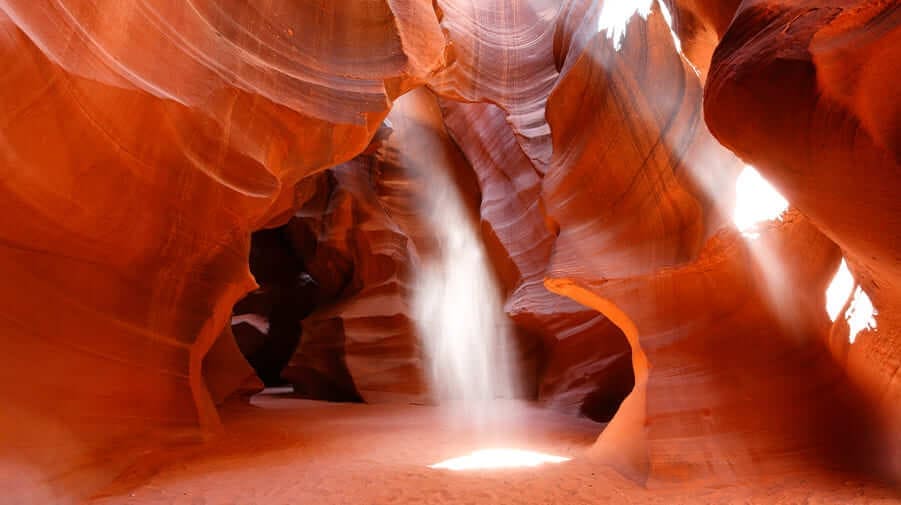
Remember, tour guides are your friend, and are always available to help you. They are fully aware that many tourists traveled great distances and long hours to see Antelope Canyon and want to get the best possible photo. Guides will choreograph visitors so that everyone can get the shot they want, even when a light beam appears that makes all the tourists frantically grab for their phone or camera and jostle for position. Sometimes, one of the guides will toss a fistful of sand right into the beam so that the sunlight reflects off the pebbles and dust, creating a visual that seems like fireworks within the canyon.
Visitors can opt for two types of tours – regular canyon tours and photography-specific tours. The photography tour allows for tripods and other professional equipment, and the tour guides can give tips on how to take your best pictures, based on their experience. Regular canyon tours still provide excellent photographic opportunities, it’s just up to the tourist to take the picture with a standard camera or smartphone. You are not allowed a tripod or any other professional photography tool, and this is strictly enforced.
Lower Antelope Canyon
Breathtaking views are just one reason the lower entrance is increasingly popular
Lower Antelope Canyon has been given the English nickname “The Corkscrew” while the Navajo term referencing it is “Hazdistazí” for “spiral rock arches.” It is a shallower V-shaped canyon that is so narrow along the surface that it is actually barely visible until the visitor is practically standing on top of the entrance.

Unlike Upper Antelope Canyon, in order to enter the visitor has to climb down into it, beginning with a very small opening on one end.
The famous light beams do not occur as often as they do in Upper Antelope Canyon, but that does not mean that visitors are missing out. Far from it.
Once the visitor climbs down the ladder and reaches the sandy bottom, the views in all directions are like something out of this world. The extraordinary carvings in the Navajo sandstone, which get their signature fiery color from iron oxide, reflect from the sunlight at almost any angle, at any time of day.
Despite the other tourists around you jockeying for position, the slot canyon – just as the Navajo elders say – is incredibly peaceful and spiritual. One cannot shake the sense of calm and tranquility when looking around. There is no distracting noise – airspace over the canyon is strictly off limits, so loud jet engines overhead will not ruin the moment – no trees or buildings obstructing your view. Almost to a person, tourists express how they felt a connection to the canyon, how it can make you feel a sense of peace and solitude – an almost calming effect that makes visitors feel like they are walking down the canyon alone, no matter how large the crowds.
Why It's Always Safety First At Lower Antelope Canyon
Again, it should be noted that access and movement within Lower Antelope Canyon is more difficult than Upper Antelope Canyon. That’s due to the fact that unlike the upper canyon – where the entrance is at ground level – you must enter from the top of the canyon and climb down several metal staircases. Once you make your way down to the sandy bottom, the ground can be uneven in places and very narrow – so narrow in fact that only one person at a time can walk through.
The staircases themselves were only installed in 1997. Prior to that, the canyon was largely an attraction for more adventure-minded tourists who would scale up and down the deep walls themselves, sometimes using small steel ladders but often using nothing more than their hands and feet, unaccompanied by guides or anyone else for that matter. They’d just pay a small fee to enter and be on their way.
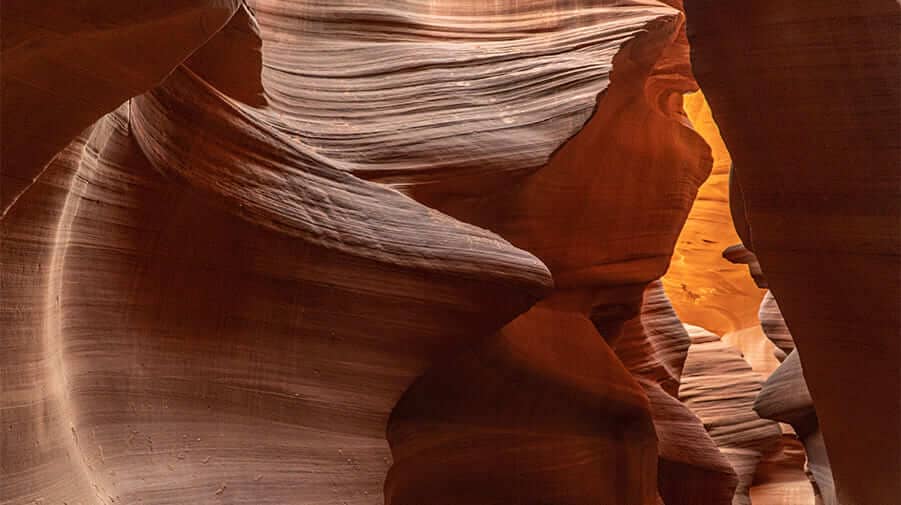
That all changed on August 12, 1997, when eleven tourists were killed in Lower Antelope Canyon by a flash flood. Very little rain fell at the site that day, but an earlier thunderstorm had dumped a large amount of water into the canyon basin, about 7 miles upstream.
As the water rapidly gained momentum running down the canyon, a 40-foot-high wall of water swept through Lower Antelope Canyon, taking with it two hikers from New Orleans, and nine from Europe. The group was washed 4 miles down the canyon, which is only 3 feet wide in some places, in a matter of minutes. The guide—who was found naked, battered, and his skin raw from the water and debris—clung to a ledge of the canyon after an ill-fated attempt to save two tourists.
Because so many died in the tragedy, including nine Europeans, it made state, national and international headlines. Families of the victims, along with countless politicians and dignitaries from around the world decried the lack of safety regulations at the canyon.
So now, instead of steel ladders that could be easily swept away by rushing waters, stairways are mounted directly into the rock. No one is allowed to enter the canyon without the presence of a guide who has extensive safety training and understands the canyon intricately. And of course, there are now much more reliable flash flood warnings.
So yes, flash flooding may still occur at Lower Antelope Canyon – after all, that’s how the canyon was formed in the first place, but proper precautions and equipment have kept tourists and visitors safe there for the last 25 years (and counting).
How To Visit Antelope Canyon
Unlike decades ago, when hikers could only visit Antelope Canyon with a compass, hiking gear and a little luck, today the Eighth Wonder of the World is accessible to everyone who wishes to see it.
Today, there are five tour companies that operate in Upper Antelope Canyon, and two that operate Lower Antelope Canyon. There is even a helicopter tour. All operators work closely with one another to coordinate entry times to prevent overbooking and bottlenecking, and to ensure every group enters and departs the canyon within the designated time frame.

In order to get the most out of your trip – especially if you are visiting from overseas or out of state – here are some simple suggestions to make sure your visit is a memorable and enjoyable experience.
First, when choosing which entryway to visit (or both) make sure you prepare yourself and understand the different terrains and challenges. Upper Antelope Canyon is at ground level, with less than a 2% incline, whereas Lower Antelope Canyon requires climbing up and down staircases, often at steep inclines. Of course, there are guides to help those that need it. (and don’t worry, everyone goes down the stairs slowly).
At the same time, Lower Antelope Canyon is easily accessible – just a 10 minute walk or so from your car. However, visiting Upper Antelope Canyon requires you to be driven to the entrance by one of the tour company trucks, so you need to budget a little more time in arriving. Also, Upper Antelope Canyon often sees much more traffic than Lower Antelope Canyon. So while the guides are incredibly knowledgeable and helpful (especially when it comes to helping you find that perfect photo) if you really dislike crowds you may want to start with Lower Antelope Canyon, or visit Upper Antelope Canyon in the so-called off-peak months of November through February, which has fewer crowds but still has breathtaking views.
What Do I Need To Take With Me To Antelope Canyon?
As far as what to bring, it’s simple. Make sure you have closed toed shoes (it is sandy after all) that are also comfortable since you will be on your feet for the entire tour. Your shoes should also not be too worn down at the soles if you are climbing or descending staircases. Apply plenty of sunscreen (you’re still in the desert) and wear a hat. If you wear contact lenses, consider opting for eyeglasses instead due to dust and sand. On windy days, dust can blow into your nose, mouth and ears. If you bring a camera, never change lenses inside the canyon.

If you are visiting Lower Antelope Canyon, temperatures are about 10 degrees cooler at the bottom of the canyon than ground level, so dress warm – especially in winter.
You are allowed to bring one bottle of water, which is strongly recommended. However, backpacks, purses, tripods, selfie sticks and food and drinks (besides your water bottle) are all prohibited. Navigating either canyon entrance requires your full attention and both hands, so keep your items to a minimum.
There are no restrooms, so plan your bathroom breaks accordingly. There are also no trash bins, which is why you are asked not to bring in food or drinks. You are visiting a natural habitat that is sacred to the Navajo people, so it is important to remember not to litter or vandalize the property. Carving your initials into the sandstone will not only get you in trouble with Navajo authorities, it will be seen as greatly disrespectful and may lead to being banned from Navajo land in the future.
Remember Your Time Zone!
One thing to keep in mind when scheduling your trip to Antelope Canyon is that while the state of Arizona does not observe Daylight Savings Time, the Navajo Nation – which is considered a sovereign nation – does not. What this essentially means is that between roughly March and October the state of Arizona is on Pacific time and then moves to Mountain time from October to March as the rest of the country springs forward (or back, it’s confusing sometimes). However, if you reside on the Navajo Nation, you will observe Daylight Savings Time and – depending on the time of year – will be one hour ahead of residents of Arizona.
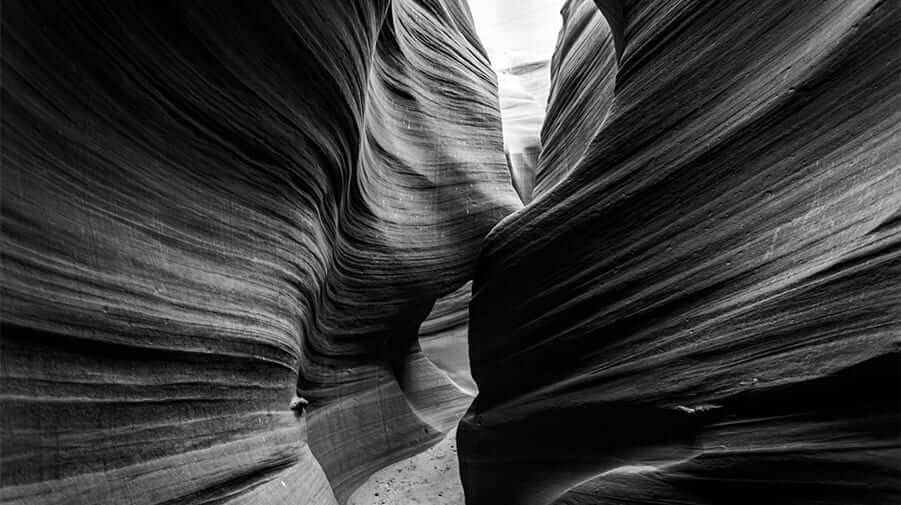
If you have a wristwatch, or some kind of analog watch to keep track of time – rather than using your cell phone – that would be something to bring with you to Antelope Canyon.
Overall, when making your reservation, be sure to confirm with your travel agent or booking service that your appointment is on Navajo time. Antelope Canyon tour companies all make sure that reservations made on their own websites are on Navajo time, so that might be the safest option. Otherwise you could wind up an hour early for your guided tour (or an hour late).
Locals Know Best - Let Your Navajo Tour Guide Help You Get The Most Out Of Your Visit
On every tour, you will be given a knowledgeable, helpful tour guide no matter which tour you take, so take advantage! Due to visitors’ near-singular interest in picture-taking, tour guides have become experts in finding just the right lighting and location to take the perfect shot. Remember, it’s not a competition between you and the other tourists. Guides are especially gifted when it comes to helping people focus on the beauty of the canyon rather than the people around them, and ensuring everyone has the time and ability to take great photos. No matter how many people are on a guided tour, everyone can come away with amazing pictures.
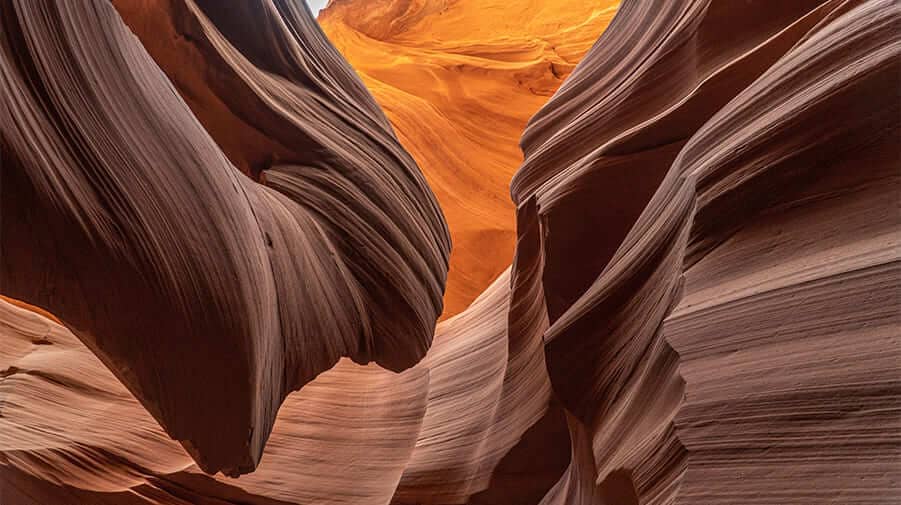
Feel free to ask questions of your guide. Most if not all guides are Navajo, and love to tell the history of their culture and how it relates to the canyon. Antelope Canyon is more than just a computer background, it is a unique natural wonder with tremendous cultural and spiritual significance to Native people. Learning more about how Navajo history and traditions will enrich your tourism experience that much more.
If you are wondering, yes, you can book tours for both Upper and Lower Antelope Canyon in one day. Just plan at least two hours between bookings to make sure you are able to enjoy one without feeling rushed and have plenty of time to head over to the other.
Without question, visiting Antelope Canyon will be one of the most rewarding excursions you will ever take. You may never see anything as beautiful or extraordinary in nature as the intricate carvings on Navajo sandstone, especially as the sun shines through the canyon. You may never forget the stories and history of the canyon as told by your guide. And you may never forget how you felt as you walked through the entrance to the canyon for the first time. It is a deeply spiritual and cultural experience, and one you won’t soon forget.
Thank you for taking the time to learn more about the wonderful Antelope Canyon, and we hope to see you soon.
Where To Stay When You Are Visiting Antelope Canyon
It can be a lengthy drive if you are coming from a major metropolitan area – and there are some nearby attractions that would help you get even more out of your trip, Horseshoe Bend, White Pocket and the Vermilion Cliffs, and Lake Powell. So here are some suggestions on places to stay if you plan on visiting Antelope Canyon – brought to you by our friends at the Arizona Office of Tourism.
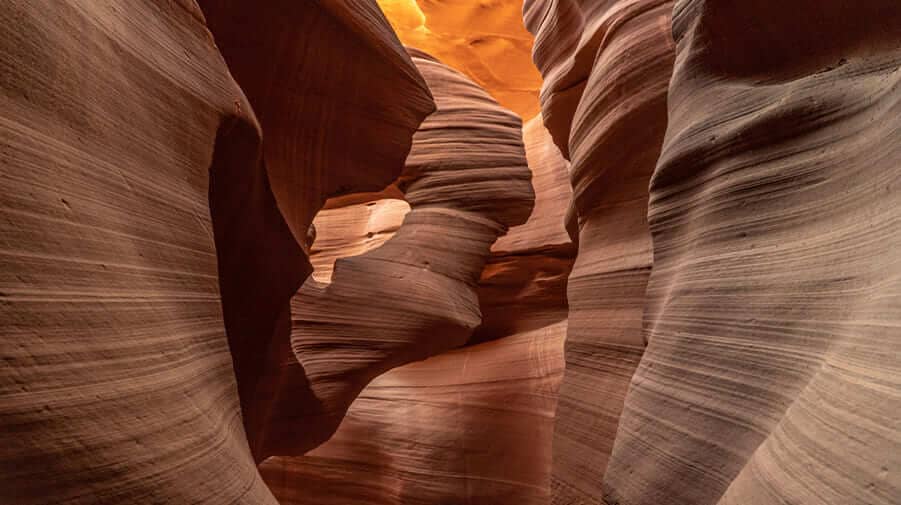
Hampton Inn and Suites Page – Lake Powell
This national chain is among the area’s newer properties and ranks high among past guests for its clean, comfortable rooms, friendly staff and free hot breakfast. The large parking lot is able to accommodate boats, buses and RVs.
The Bear’s Den B&B
Owners “Bubba and Deb-B” operate this cozy three-room bed and breakfast in Page that’s fully ADA-compliant. Amenities include pillowtop mattresses, a small fridge and microwave, private bathrooms, and plenty of bear decor.
Shash Dine’ Eco-Retreat
For a truly unique stay, book a Najavo hogan or sheepherder wagon at this sustainable glamping campsite and B&B operated by Baya, a member of the Navajo Nation. You will stay on Navajo land in one of eight simple accommodations—no electricity or running water, but fresh drinking water—with nothing but views for miles.
Lake Powell Resort
If a visit to Lake Powell and Glen Canyon National Recreation Area is on your list, you can’t get closer than a stay at this resort located at Wahweap Marina in Page. Hotel guests can book a boat tour, dinner cruise or rent their own powerboat for an unforgettable day on the water.

